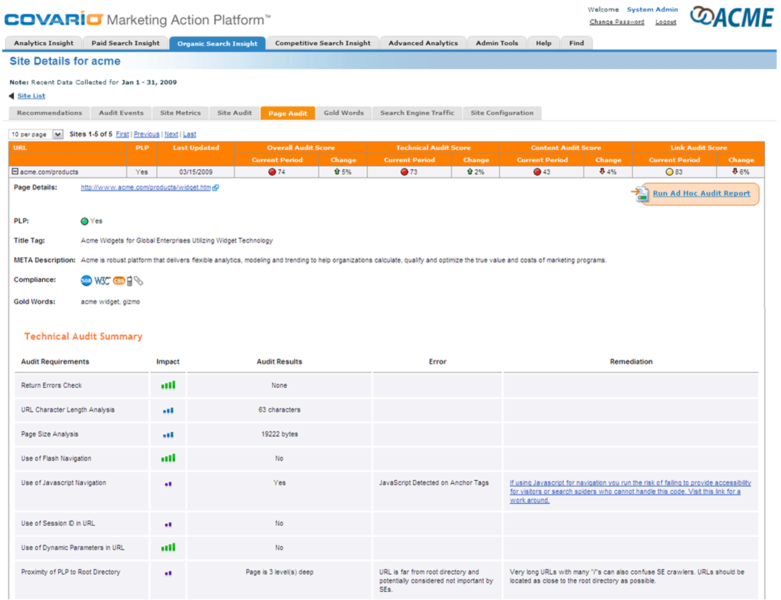The Science Of Scoring Your SEO
SEO is an art. (Hence, the name of my and my co-authors’ brand new book, The Art of SEO). Crafting copy that sells, as well as ranks, is an art. So is link baiting. But SEO is also a science. Crafting rewrite rules, robots.txt directives, and so forth is pretty geeky stuff. The science side […]
SEO is an art. (Hence, the name of my and my co-authors’ brand new book, The Art of SEO). Crafting copy that sells, as well as ranks, is an art. So is link baiting. But SEO is also a science. Crafting rewrite rules, robots.txt directives, and so forth is pretty geeky stuff. The science side of SEO is where I spend most of my time.
Another dichotomy is that SEO is both subjective and objective. The point at which a title tag, URL, or headline is “good enough” and thus moving on to the next task is warranted — that is certainly subjective. Also consider what might comprise the most optimal URL structure? Does it end in / (slash) or a file extension like .html? Again, subjective.
In my view, SEO for the most part is cut-and-dry, it’s objective. That’s because it can all be boiled down to an algorithm, and in fact, it already has. The algorithm I speak of, of course, is Google’s (or Yahoo’s, or Bing’s). The SEO practitioner’s challenge is to reverse-engineer that algorithm to the best of their ability. But it shouldn’t stop there. Why not write your own algorithm — an approximation of the search engine’s own algorithm, one that teases out the various signals and accurately assesses the quality, relevance and importance of these signals without human intervention/assistance?
Running algorithmic analysis on a site-by-site and a page-by-page basis will then allow you to ascertain a site’s SEO health, and more importantly, the subsequent actions required in this never-ending process known as optimization. That is data-driven decision-making, my friends, and it will be a key driver in the next stage in the evolution of SEO.
To be effective, SEO scoring has to get granular. Knowing you scored an 89 out of 100, or a B+, overall with your SEO may be reassuring, but there weren’t any next steps that followed from that knowledge. The same is true even if you individually score each of the major SEO areas of focus. In my SEO Report Card column for Practical Ecommerce, I (arbitrarily) chose the following areas of focus: Home Page Content, Inbound Links and PageRank, Indexation, Internal, Hierarchical Linking Structure, HTML Templates and CSS, Secondary Page Content, Keyword Choices, Title Tags, and URLs. I don’t claim that these are the best “buckets”. Nonetheless, scoring such broad areas is still not actionable, really.
Score the title tags, internal anchor text, keyword prominence, H1s, meta descriptions and so forth separately, and on a page-by-page basis, and now you’re talking!
SEO effectiveness can be deconstructed into its many components. It can be benchmarked against competitors. Inferences can be made, priorities can be set, content can be massaged, link juice can be directed. Consequently, the SEO practitioner relies less on their gut and more on the data to drive their actions.
One enterprise-level SEO scoring technology that supports such a data-driven approach to SEO is Covario’s Organic Search Insight — which gets so granular that components of navigation, URLs and so forth are assessed (as can be seen in the screenshot below). Craig MacDonald, VP of Marketing and Product Management told me, “The impact analysis can also be statistically modeled, based on gathering data across many sites over time in order to ascertain the relationship between changes in factors and the impact of those relative factors on the various search engines – i.e., the science can be rigorously applied.” From that, specific recommendations are automatically made and prioritized.
SEO is a moving target, one that is heavily dependent on algorithm shifts, site changes/updates, the competitive landscape in which one operates, etc. As such, you must continuously monitor and evaluate, ideally with an automated tool. In fact, such a tool is mandatory if you have a large site and you want your SEO activities to be scalable. With this monitoring in place, a page element (like a meta description) that goes AWOL can be flagged and the issue addressed (e.g. internal resources deployed) much faster than would be otherwise possible. Even better if the webmaster can be flashed warnings prior to making site modifications that will be detrimental to SEO.
Opinions expressed in this article are those of the guest author and not necessarily Search Engine Land. Staff authors are listed here.
Related stories
